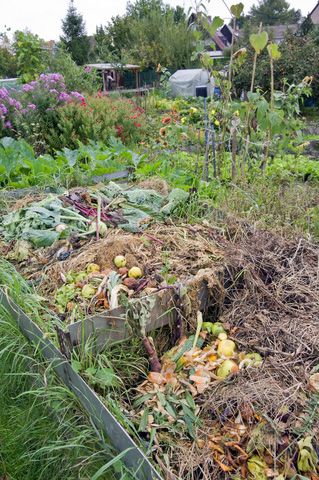Soil Enhancement: Composting
Learn about the difference between “hot” and “cold” methods of composting. Composting is a method of recycling naturally decomposing matter. Ingredients, size of the pile, local weather conditions, and your maintenance habits will affect the outcome. Note that shredded leaves, chipped wood, and chopped food scraps generally decompose more quickly than whole or large pieces. […]

Learn about the difference between “hot” and “cold” methods of composting.
Composting is a method of recycling naturally decomposing matter. Ingredients, size of the pile, local weather conditions, and your maintenance habits will affect the outcome. Note that shredded leaves, chipped wood, and chopped food scraps generally decompose more quickly than whole or large pieces.
Active, or Hot Composting
The quickest way to produce rich garden humus is to create a hot, or active, compost pile. It is called “hot” because it can reach an internal temperature of 160°F (140°F is best) and “active” because it destroys, essentially by cooking, weed seeds and disease-causing organisms. The size of the pile, the ingredients, and their arrangements in layers are key to reaching that desired outcome.
Size: A hot compost pile should be a 3-foot cube, at minimum; a 4-foot cube is preferred. The pile will shrink as the ingredients decompose.
Ingredients for a Compost Pile:
- One part high-carbon materials (shredded, dry plant matter such as leaves, twigs, woody stems, corn cobs)
- One part high-nitrogen green plant matter (green plant and vegetable refuse, grass clippings, weeds, trimmings, kitchen scraps—but avoid meat, dairy, and fat) and good-quality soil
Instructions for Making a Compost Pile:
Pile the ingredients like a layer cake, with 2 to 4 carbon materials on the bottom (twigs and woody stems here will help air to circulate into the pile). Next, add a layer of soil. Add 2 to 4 inches of nitrogen-based materials, followed by soil. Repeat until the pile reaches 2 to 3 feet high.
Soak the pile at its start and water periodically; its consistency should be that of a damp sponge.
Add air to the interior of the pile by punching holes in its sides or by pushing 1- to 2-foot lengths of pipe into it.
Check the temperature of the pile with a compost thermometer or an old kitchen thermometer. A temperature of 110°F to 140°F is desirable. If you have no heat or insufficient heat, add nitrogen in the form of soft green ingredients or organic fertilizer.
If a foul odor emanates from the pile, flip the compost to introduce more air. If you added meat or dairy products, it is best to remove and discard them.
Once a week, or as soon as the center starts to cool down, turn the pile. Move materials from the center of the pile to the outside. (For usable compost in 1 to 3 months, turn it every other week; for finished compost within a month, turn it every couple of days.)
Cold, or Passive Composting
Cold, or passive, composting uses many of the same type of ingredients as hot composting and requires less effort from the gardener, yet the decomposition takes substantially longer—a year or more.
To cold compost, pile organic materials (leaves, grass clippings, soil, manures—but avoid dog, cat, and human waste) as you find or accumulate them. Bury kitchen scraps in the center of the pile to deter insects and animals. Avoid adding meat, dairy, and fat. Also avoid weeds; cold compost piles do not reach high temperatures and do not kill weed seeds. (In fact, weeds may germinate in a cold pile.)
Compostable Materials
In addition to the ingredients mentioned above, any of these items may be added to a compost pile:
- Coffee grounds and tea bags
- Dry goods (crackers, flour, spices)
- Eggshells
- Hair
- Nutshells
- Pasta (cooked or uncooked)
- Seaweed
- Shredded paper/newspaper
Source: The Old Farmer’s Almanac


